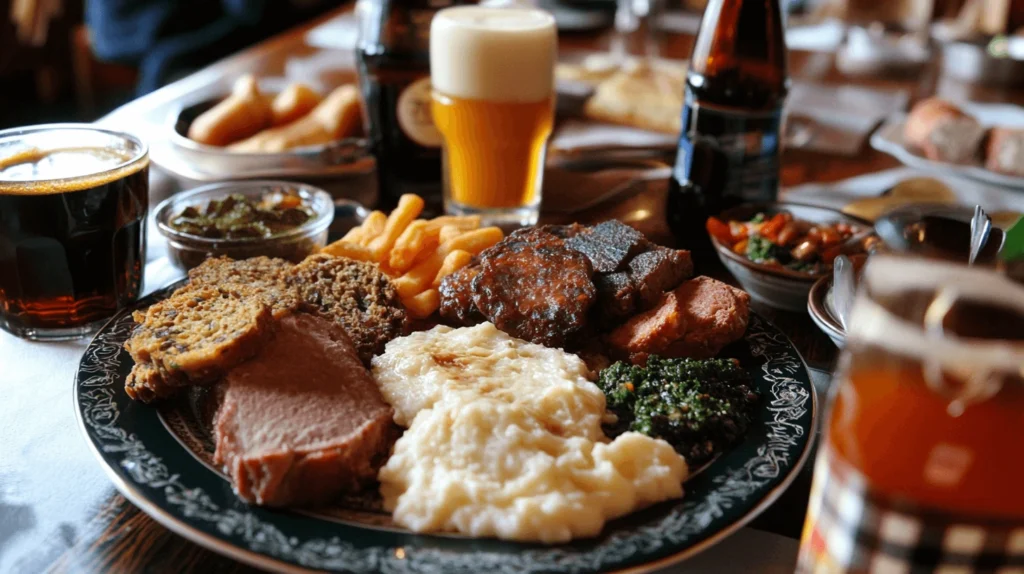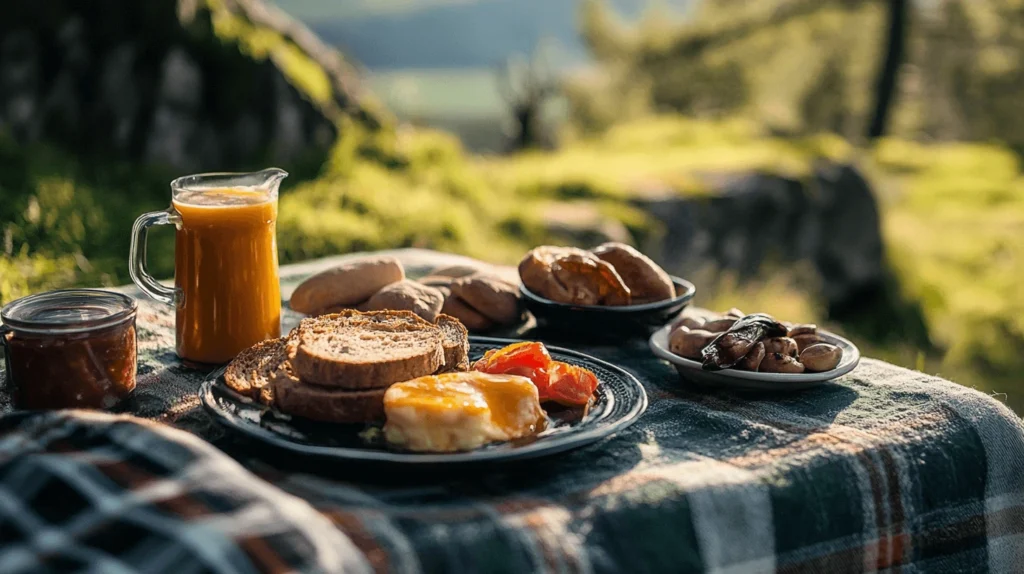When it comes to hearty, traditional breakfasts, few can rival the iconic Scottish and Irish versions. Both are bursting with flavor and history, but they’re not as similar as they might seem at first glance. So, what exactly sets them apart? Let’s explore the origins, key ingredients, and the cultural essence of these breakfasts.
Introduction to the Scottish and Irish Breakfast
A traditional breakfast is like a comforting hug on a plate—rich, filling, and perfect for fueling your day. In Scotland and Ireland, breakfast isn’t just about food; it’s about tradition and pride. But here’s the thing: while they may look alike to the untrained eye, Scottish and Irish breakfasts each have their unique flair.
Imagine two siblings who look similar but have completely different personalities. That’s Scottish and Irish breakfasts for you. Let’s start by digging into their roots.
Origins of the Traditional Scottish Breakfast
Scottish breakfasts trace their roots back to rural communities. Farmers and laborers needed energy-packed meals to survive long, cold mornings in the fields. Over time, this humble fare transformed into a celebrated culinary tradition. Scots have always embraced local ingredients, and that’s why dishes like haggis and tattie scones made their way to the breakfast table.
Origins of the Traditional Irish Breakfast
On the other side of the Irish Sea, the Irish breakfast has its own story. This meal was designed for farmers who also needed hearty food to fuel their days. Over the years, it evolved into a staple of Irish hospitality. Today, an Irish breakfast isn’t just a meal; it’s a symbol of comfort and warmth. And let’s be honest—can you even call it an Irish breakfast without soda bread?
Key Ingredients of a Scottish Breakfast
The Scottish breakfast is a plate of pure indulgence, filled with unique and traditional components. Here’s what makes it stand out.
Black Pudding vs. White Pudding
Let’s address the elephant—or rather, the pudding—in the room. Both breakfasts feature black pudding, a savory blood sausage. But in Scotland, white pudding often joins the party. It’s like black pudding’s cousin—minus the blood but packed with oatmeal and spices.
“White pudding adds a subtle sweetness that balances the savory flavors of a Scottish breakfast.”
The Role of Haggis in Scottish Breakfast
Ah, haggis! This iconic Scottish dish often sneaks its way onto the breakfast plate. Made from sheep’s offal, oatmeal, and spices, haggis is a love-it-or-hate-it kind of food. But for Scots, it’s a breakfast must-have that adds a rich, earthy flavor.
Tattie Scones: A Scottish Specialty
Tattie scones are the unsung heroes of a Scottish breakfast. These potato-based scones are fried to perfection and are often used to mop up runny egg yolks or baked beans. Think of them as Scotland’s answer to hash browns, but fluffier and more versatile.
Key Ingredients of an Irish Breakfast
The Irish breakfast has its own star players that set it apart from its Scottish sibling. Let’s break it down.
Soda Bread and Its Variants
Soda bread is a cornerstone of Irish cuisine, and breakfast is no exception. This quick bread, made with baking soda instead of yeast, has a dense yet soft texture that’s perfect for slathering with butter or dipping into egg yolks. It’s the Irish equivalent of a morning hug.
“Freshly baked soda bread can turn a simple breakfast into an extraordinary experience.”
Irish Rashers: What Makes Them Unique?
What’s a rasher, you ask? It’s Irish bacon, and it’s thicker, juicier, and a whole lot more satisfying than your average strip of American bacon. Its slightly sweet flavor comes from being cured, and it pairs beautifully with eggs and sausages.
The Role of Boxty in Irish Breakfast
Boxty, a traditional Irish potato pancake, adds a delightful crunch to the Irish breakfast. Think of it as a hybrid between a pancake and a hash brown. It’s crispy on the outside, soft on the inside, and absolutely addictive.
Similarities Between Scottish and Irish Breakfasts
Now, you might be wondering: “Aren’t there any overlaps?” Of course! Both breakfasts share some common ground, especially when it comes to the basics.
Shared Components: Eggs, Sausages, and Bacon
No matter where you are, you’ll find eggs, sausages, and bacon on the plate. These staples form the foundation of both breakfasts, ensuring a hearty start to the day.
Fun fact: While the cuts and seasoning of bacon and sausages vary, the love for these meaty treats is universal.
Influence of British Full Breakfast
It’s impossible to ignore the influence of the traditional British full breakfast. Many elements, like baked beans and grilled tomatoes, appear in both Scottish and Irish versions. However, each country has put its own spin on the concept.
Differences in Cooking Techniques
Now that we’ve covered ingredients, let’s talk about how these breakfasts are cooked. Trust me, this is where the magic happens.
Frying vs. Baking: Regional Preferences
Scottish breakfasts tend to be fried, giving them a rich, crispy texture. Meanwhile, the Irish sometimes prefer to bake certain components, especially breads like soda bread. It’s like comparing a roaring fire to a warm oven—both cozy, but distinct.
Use of Spices and Seasonings
Scottish breakfasts often feature bold flavors, thanks to ingredients like haggis and black pudding. In contrast, Irish breakfasts lean toward milder, more comforting spices. It’s a subtle difference, but one that makes each breakfast unique.

Table: Nutrition Facts (Scottish vs. Irish Breakfast)
| Component | Scottish Breakfast | Irish Breakfast |
|---|---|---|
| Calories (Approx.) | 900-1200 kcal | 800-1100 kcal |
| Protein | High (Sausages, Eggs) | High (Rashers, Eggs) |
| Carbohydrates | Moderate (Tattie Scones) | Moderate (Soda Bread) |
| Fat | High (Fried Items) | High (Rashers, Sausages) |
| Unique Ingredients | Haggis, Tattie Scones | Boxty, Soda Bread |
Common Misconceptions About Scottish and Irish Breakfasts
When it comes to food, myths and misconceptions are bound to arise. Let’s clear the air about some common misunderstandings surrounding Scottish and Irish breakfasts.
Do Both Always Include Porridge?
You might think that every Scottish or Irish breakfast includes porridge, but that’s not necessarily true. While porridge is a beloved staple in Scotland, it doesn’t always make an appearance at breakfast. In Ireland, porridge is popular too, but it’s not as synonymous with breakfast as soda bread or rashers.
“Porridge might warm the heart, but don’t be surprised if it’s swapped out for a tattie scone or a slice of soda bread.”
Are They Always Served with Tea?
Another common belief is that tea is a non-negotiable part of these breakfasts. While a strong cup of tea often accompanies both meals, coffee has also become a popular choice. So, whether you’re a tea lover or a coffee enthusiast, there’s room for both on the breakfast table.
Nutritional Aspects and Health Implications
Let’s face it—traditional breakfasts aren’t exactly the poster child for healthy eating. But that doesn’t mean you can’t enjoy them in moderation. Here’s a closer look at the nutritional aspects.
Caloric Content: A Comparison
Scottish and Irish breakfasts are calorie-dense, thanks to their fried components and hearty portions. A typical serving can range between 800 and 1200 calories, depending on the ingredients. That’s nearly half the daily calorie intake for an average person!
Can They Fit Into a Balanced Diet?
The good news is that these breakfasts can fit into a balanced diet when enjoyed occasionally. To lighten things up, consider grilling items instead of frying, or swapping traditional sausages for leaner alternatives. And hey, no one says you have to eat the full spread every single time!
Common Problems When Making These Breakfasts
If you’ve ever tried to recreate a Scottish or Irish breakfast at home, you know it’s not as easy as it looks. Here are some common challenges and how to tackle them.
Difficulty Finding Authentic Ingredients
Finding authentic ingredients like haggis, tattie scones, or boxty can be a struggle, especially if you live outside the UK or Ireland. But don’t worry—many supermarkets carry international products, and online stores can be a lifesaver.
Pro Tip: If you can’t find tattie scones, try making them at home with mashed potatoes, flour, and butter. They’re surprisingly easy to whip up!

Mistakes in Preparation Techniques
Overcooking sausages, under-frying eggs, or burning soda bread—these are all common pitfalls. The trick is to cook everything slowly and give each ingredient the attention it deserves. Think of it like orchestrating a symphony: timing is everything.
Solutions for Creating an Authentic Experience
To create an authentic experience, focus on the small details. Serve your breakfast on a warm plate, pair it with traditional condiments like marmalade or brown sauce, and don’t forget a pot of freshly brewed tea. It’s the little touches that make all the difference.
Regional Variations in Scottish and Irish Breakfasts
While the core elements of these breakfasts remain consistent, regional variations add a touch of local flair.
How Breakfast Varies Across Scotland
In the Highlands, you might find venison sausages or oatcakes on your plate. In coastal areas, seafood like smoked haddock or kippers often makes an appearance. These regional twists reflect Scotland’s diverse culinary heritage.
Regional Twists in Ireland’s Breakfast
In Northern Ireland, an “Ulster Fry” often replaces soda bread with potato bread and includes mushrooms or baked beans. Meanwhile, in the south, you’re more likely to encounter freshly baked brown soda bread alongside your rashers and eggs.
Cultural Significance of These Breakfasts
Breakfast isn’t just about food; it’s about culture, tradition, and a sense of belonging. Let’s explore the deeper meaning behind these iconic meals.
Role in Festivities and Celebrations
Scottish and Irish breakfasts often feature in special occasions, from weddings to holiday mornings. They’re a way of bringing people together and celebrating the richness of local traditions. In Scotland, a hearty breakfast might even kick off the festivities on Hogmanay (New Year’s Eve).
“A traditional breakfast is more than just a meal; it’s a celebration of community, heritage, and shared stories.”
Representations in Media and Literature
Both breakfasts have made their way into literature and film, often symbolizing hospitality and warmth. From James Joyce’s Ulysses to modern travel shows, these meals continue to capture the imagination of people around the world.
Conclusion
Appreciating the Unique Charm of Both Breakfasts
Scottish and Irish breakfasts are like two sides of the same coin. They share common elements, yet each brings its own distinct personality to the table. Whether you’re drawn to the bold flavors of haggis and tattie scones or the comforting simplicity of soda bread and rashers, there’s something to love about both.
Final Thoughts on Scottish vs. Irish Breakfast
In the end, it’s not about which breakfast is better—it’s about celebrating the diversity of these culinary traditions. So, the next time you’re torn between a Scottish and an Irish breakfast, why not try both? After all, life’s too short to pick just one!

